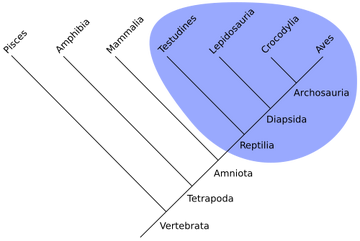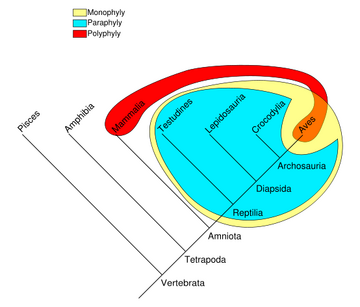
Monophyly

Comparison: monophyly = yellow, polyphyly = red, paraphyly = aqua
In common cladistic usage, a monophyletic group is a clade, consisting of an ancestor and all its descendants. The term is synonymous with the uncommon term holophyly.
However, this definition of the term took some time to be accepted. When the cladistic school of thought became mainstream in the 1960s, several alternative definitions were in use. Indeed, for some time taxonomists would use the term without even defining it, leading to great confusion in the early literature.[1]
Definitions[]
On the broadest scale, definitions fall into two groups.
- The widest, and arguably[2] the semantically correct meaning of the word,[3] is any two or more groups sharing a common ancestor.[4] Since all life on Earth shares a common ancestor, this definition strips the term of scientific utility. Therefore, scientists today restrict the term to holophyletic groups only - that is, groups consisting of all the descendants of one (usually hypothetical) common ancestor.[5] However, when considering taxonomic groups such as genera and species, the most appropriate nature of this common ancestor is unclear. Assuming that this is one individual or mating pair is unrealistic for species, which are by definition interbreeding populations.[1]
- However, using a broader definition, such as a species and all its descendants, doesn't really work to define a genus.[1] A satisfactory and comprehensive cladistic definition of a species or genus is in fact impossible, and reflects the impossibility of seamlessly impressing a gradualistic model of continual change over the 'quantum' Linnean model, where species have defined boundaries, and intermediaries between species cannot be accommodated.[6]
Controversy[]
This incompatibility with the Linnean model led to an initial rift, not entirely healed, between the cladistic and Linnean schools of thought. Extreme cladists challenged the validity of Linnean taxa such as the Reptilia. Because birds, although descended from reptiles, are not themselves considered to be reptiles, cladists demanded that the taxon Reptilia be dismantled: a request that taxonomists were unwilling to heed. This stand-off was eventually resolved to a degree by the construction of the term 'paraphyletic' to describe closely related groups which included most but not all of the descendants of a common ancestor.[4]
However, the coining of this term led to yet more confusion. Some scientists considered paraphyletic groups to be monophyletic (as they shared a common ancestor), where others insisted that monophyletic should continue to refer only to holophyletic groups.[4] Another term, polyphyletic, fell outside of the definition of monophyly. A strict explanation of a paraphyletic group has not been published, but the consensus appears to be that paraphyletic groups consist of a monophyletic group, minus one smaller constituent clade - for instance "Reptiles minus birds". Polyphyletic groups can be thought of as a number of unrelated clades, for instance "warm blooded animals" = "birds plus mammals". Non-holophyletic groups are of little use for analysis of evolutionary processes, hence the calls for their "unnaming" - even though they are useful to scientists who are less concerned with the evolutionary past of groups.[4] Naming is also a problem for monophyletic groups: because the number of ancestors from which to root monophyletic groups is almost infinite, giving each clade a unique name is impossible[4] - as illustrated by the failed attempts to instigate a system called the Phylocode. Names obfuscate the really interesting part, which is the branching order, and are therefore of little utility to the cladist - at odds with the taxonomist, who since the time of Linnaeus has been naming species. Intermediate, and particularly fossil, taxa can be considered to fall 'just outside' a widely accepted taxon. For instance, Archaeopteryx appears more reptilian than bird - it has teeth and a number of other reptilian characteristics. But it also has feathers, which have traditionally been considered as an avian trait. It lacks a number of other traits shared by all birds, so can't fall within the bird clade. To reflect this phylogenetic proximity, it is termed a 'stem group bird' - i.e. it lies on a branch close to the lineage that led to true birds, as recognised by a taxonomist. This concept closes the gap between taxonomy and cladistics at a broader scale,[6] but is difficult to apply at a species-level resolution.
See also[]
- Clade#Naming clades - different ways of practically naming and defining clades
- Holophyly
References[]
- ^ a b c Simpson, George (1961). Principles of Animal Taxonomy. New York: Columbia University Press. ISBN 0231024274.
- ^ Colless, Donald H. (March 1972), "Monophyly", Systematic Zoology 21 (1): 126–128, doi:
- ^ Envall, Mats (2008). "On the difference between mono-, holo-, and paraphyletic groups: a consistent distinction of process and pattern". Biological Journal of the Linnean Society 94: 217. doi:.
- ^ a b c d e Ashlock, Peter D. (March 1971), "Monophyly and Associated Terms", Systematic Zoology 20 (1): 63–69, doi:
- ^ Hennig, W. (1966), Phylogenetic systematics, University of Illinois Press
- ^ a b Budd, G.E.; Jensen, S. (2000), "A critical reappraisal of the fossil record of the bilaterian phyla", Biological Reviews 75 (02): 253–295, doi:, http://journals.cambridge.org/production/action/cjoGetFulltext?fulltextid=624